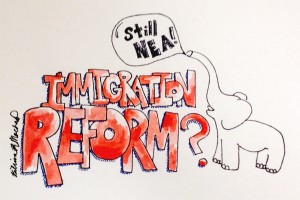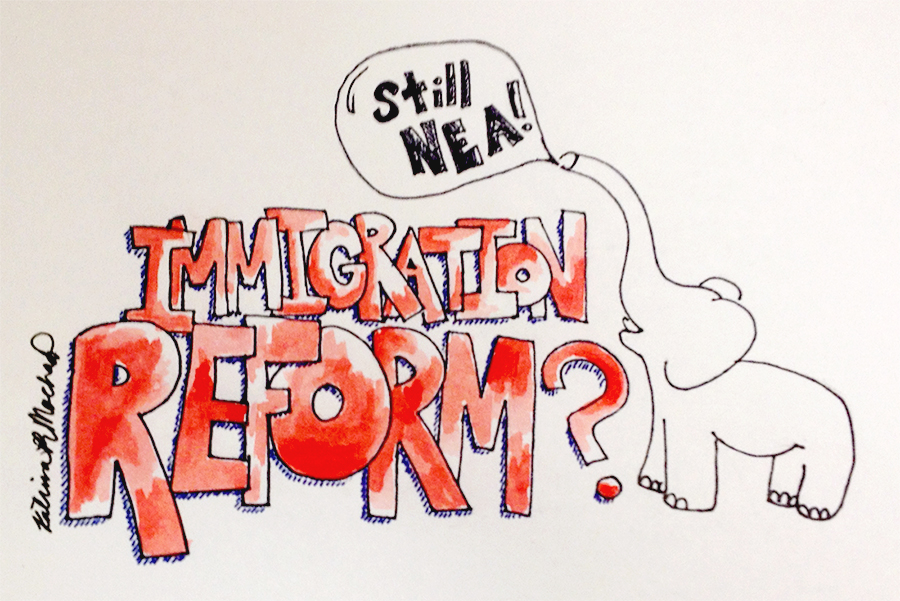
“The definition of insanity, according to Einstein’s over-used proverb, is ‘doing the same thing over and over again and expecting different results.’” These were the words with which the Republican National Committee (RNC) chose to open its Growth and Opportunity Project in the aftermath of Mitt Romney’s 2012 general election defeat. While I wouldn’t go so far as to call half of the United States’ largely two-party system “insane,” the inclusion of such an adage is a tacit admission that perhaps it’s time for this grand old dog to learn some big new tricks. With considerable demographic change due to come in the near future, it could be that this new trick features a distinctly Hispanic tint.
The RNC dispatch was commissioned after a tumultuous and often disappointing handful of years for Republicans. In 2009, the GOP witnessed the ascension of the Tea Party, an amorphous group that was tied together only by its deep enthusiasm for deficit reduction and small government, with its most notable political action to date the key role it played in bringing about the 2013 government shutdown. The brand of fervent conservatism that the Tea Party embodies was present in the Republican Party before 2009, but as Tea Party politicians and activists gathered steam and publicity, ideological purity has become priced at a higher premium in the GOP at large. This shift away from moderation within the Republican Party only rubbed salt into a wound opened after the 2012 presidential race. President Barack Obama won reelection and outstripped Mitt Romney in three core Democratic base demographics: young people, women and minorities. The statistics speak for themselves, as Obama’s margins of victory were wide — most significantly, his 80 percent of non-white voters to Romney’s 17 percent.
That last statistic left Republicans on edge, and not for the first time: The latent power of non-white voters had been previously demonstrated by Obama’s first presidential campaign. He successfully mobilized African-American, Latino and Asian communities, and though this only increased turnout in those demographics by a handful of points, it was nonetheless a critical component of his victory. In 2012, non-whites comprised a record-high 26.3 percent of the vote — two percentage points higher than in the previous presidential election. In the future, the American electorate will only become more diverse, with much of this growth coming from the Latino population. Latinos are projected to surpass whites as the largest ethnic group in California, and as we are always told, so California goes, so goes the nation. Or, as Alison Lurie put it, “As one went to Europe to see the living past, so one must visit Southern California to observe the future.”
During Obama’s elections, as well as before, Democrats have a trend of sweeping the Latino vote. Thus, political strategists are warning Republicans that if Democrats are able to integrate this group into their electoral coalition as permanently as they have African Americans, the future of Presidential elections will look very blue. The Democratic Party has decisively taken the African-American vote since the passage of the Civil Rights Act of 1964, leading some to suggest that African-American voters are monolithic, rigidly supporting Democrats at all levels of government. In comparison, neither party has yet so extensively won the Latino vote. Democrats won majorities with Latinos in every presidential election since President Carter, but Republican presidential candidates have still benefitted from Hispanic support in some races — President George W. Bush won 40 percent of the demographic in his bid for reelection. The Latino vote is sometimes referred to as a sleeping giant: Latinos represent a vast pool of untapped electoral power with more than 20 million eligible to vote and a little more than nine million voting in the 2012 election. Furthermore, their population is comparatively young: Approximately a quarter of the 52 million Hispanics in the United States are under the age of 18. As such, they have the potential to become an increasingly pivotal voting bloc in future generations. Between 2012 and 2016, 3.3 million Latino citizens will become eligible to vote.
Innumerable political analyses have consequently come to the conclusion that if Republicans fail to consider immigration reform while campaigning for the 2014 elections, their hopes for winning the White House, or improving their share of the Latino vote, are nonexistent. This reasoning is often backed up by a sound bite contrasting the Hispanic vote performance of President George W. Bush — a Republican who supported immigration reform — against of that of their recent presidential nominee. Another line of thought presumes that many Latinos are immigrants; as such, immigration reform must be a top political priority for Hispanics. The presumption comes from within the party as well. Lindsey Graham of South Carolina stated, “We’re in a demographic death spiral as a party…and the only way we can get back in good graces with the Hispanic community, in my view, is pass comprehensive immigration reform.”
Naturally, then, one of the GOP’s chief goals post-2012 has been to revitalize its message to minorities — particularly Hispanics. In the section recommending an RNC Growth and Opportunity Inclusion Council, a subsection of the Growth and Opportunity Project devoted to Republicans’ relationship with Latino voters, tellingly exceeded other minority’s subsections by at least one page. Through research with Hispanic groups, the report revealed, “Too often Republican elected officials spoke about issues important to the Latino community using a tone that undermined the GOP brand within Hispanic communities. Repairing that relationship will require both a tone that ‘welcomes in’ as well as substantial time spent in the community demonstrating a commitment to addressing its unique concerns.” The report recommended elevating Latino leaders within the party infrastructure, connecting to Hispanics by emphasizing family values, and making inroads in Hispanic communities by building relationships with constituents, as the Democratic Party has. Inevitably, the report also addressed immigration reform: “If Hispanic Americans hear that the GOP doesn’t want them in the United States, they won’t pay attention to our next sentence. It doesn’t matter what we say about education, jobs or the economy…In essence, Hispanic voters tell us our Party’s position on immigration has become a litmus test, measuring whether we are meeting them with a welcome mat or a closed door.”
An important first step would be to actually understand what it means, or doesn’t mean, to be Latino or Hispanic. This failure of complexity is not one that is restricted to the Republican Party, but is propounded by news media as a whole. The most important reality to consider, before disputing arguments that immigration reform is an ace in the hole, is that these labels have morphed into classifications for people who don’t necessarily identify with the terms, used by people who are outside the demographic. An article analyzing Latino identity by Carlos Lozada states, “only about a quarter of Hispanic adults say they identify themselves most often as Hispanic or Latino. About half say they prefer to cite their family’s country of origin, while one-fifth say they use “American.” Among third-generation Latinos, nearly half identify as American. There is little coherence to what Latino classifies regarding culture, language, race or origin. Latinos can be white, black or any other race, though the term has certainly become racialized in American society. They don’t necessarily speak Spanish, nor are they all Catholic. And all this is to also ignore that there is a distinction between Latino and Hispanic, though it is normal for both academia and media to use them interchangeably — as is the case here. Understanding the breadth and diversity of those called Hispanic Americans communicates, better than anything else, the folly of pinning their political support to a single issue.
Moreover, the electoral value of the Latino vote — and immigration reform itself — has been wildly oversimplified by an oversaturated news cycle as it speculates about Republican campaign strategies and the possibility of immigration reform while Obama’s second term term winds down. But a survey of the broader literature suggests that, actually, immigration reform may not be the golden ticket to winning the Latino vote. In a decade, when Hispanics will potentially control a powerful bloc of political power, it will probably be even more difficult to cement a voting bloc. It’s even not clear that Republicans will be in a dire political situation if they do not win the Latino vote over with immigration reform. On immigration reform, Pew conducted a survey in 2013 among the Hispanic community and found a number of issues consistently come before immigration reforms as a political priority for Hispanics. Education was the most important issue to those surveyed, while immigration lagged as the fourth most important, with only 32 percent deeming it “extremely important.” As such, it’s plain to see that Hispanic voters are plagued by much the same worries as other Americans are.
Considering the standard midterm election rebuke of the president’s party, Republicans will probably do just fine these midterms. They have a shot at the Senate, can stand to gain some seats in the House and will not doom themselves for the 2016 election. GOP politicians would be daring to talk about immigration reform — a topic not typically popular among the primary electorate, a group that falls farther to the right than the general election electorate. Immigration reform will likely be left off the table, and Latino voters won’t likely affect the “vast majority of Republican races.” According to the New York Times, “In the Senate races likely to determine whether Democrats or Republicans control the chamber, Hispanic voters will probably make up less than three percent of the electorate.”
Republicans can increase their share of the Hispanic vote, if they continue to adjust their message and approach. As we now should take for granted, Latinos, whose enfranchised population is expected to grow by 40 percent through 2030, are a diverse group that votes more similarly to other Americans than most people expect. Republicans can focus on winning middle-class Hispanics in the future, and perhaps replicate Romney’s solid performance with middle-class white voters in this demographic. A strong policy on education and continuing effort to streamline Hispanic politicians in the establishment will go some way to achieve this. As with all things complex, the Latino vote won’t be solved by a quick fix like immigration reform. Critical thinking, experimentation and effort are the tools Republicans need on the road to 2016. If they manage to do this, who knows, perhaps their next election debrief won’t need an Einstein repeat.

Excellent analysis! The GOP would be wise to heed Sullivan’s advice. This is so true: “The Latino vote is sometimes referred to as a sleeping giant: Latinos represent a vast pool of untapped electoral power with more than 20 million eligible to vote and a little more than nine million voting in the 2012 election. Furthermore, their population is comparatively young: Approximately a quarter of the 52 million Hispanics in the United States are under the age of 18. As such, they have the potential to become an increasingly pivotal voting bloc in future generations. Between 2012 and 2016, 3.3 million Latino citizens will become eligible to vote.”